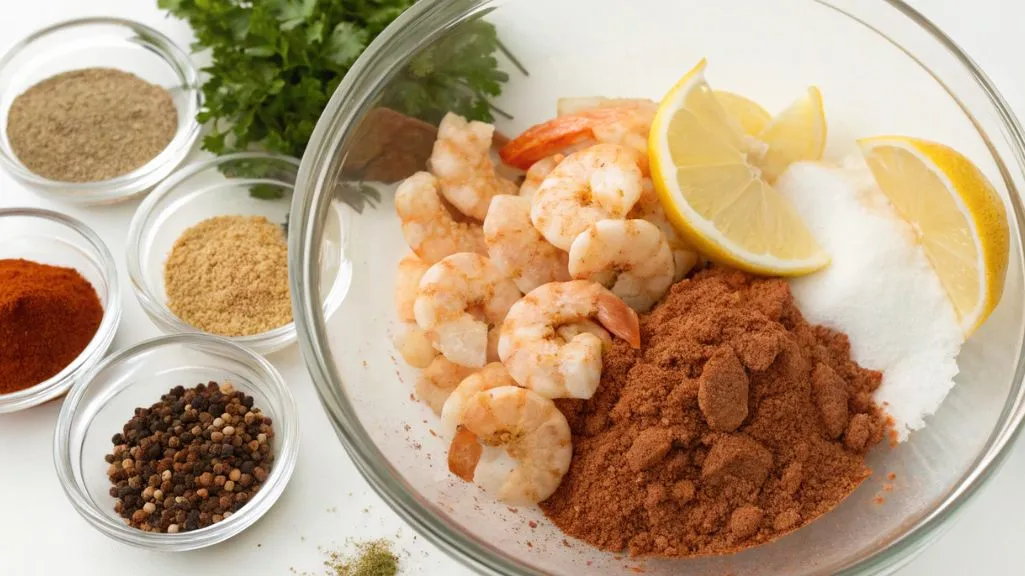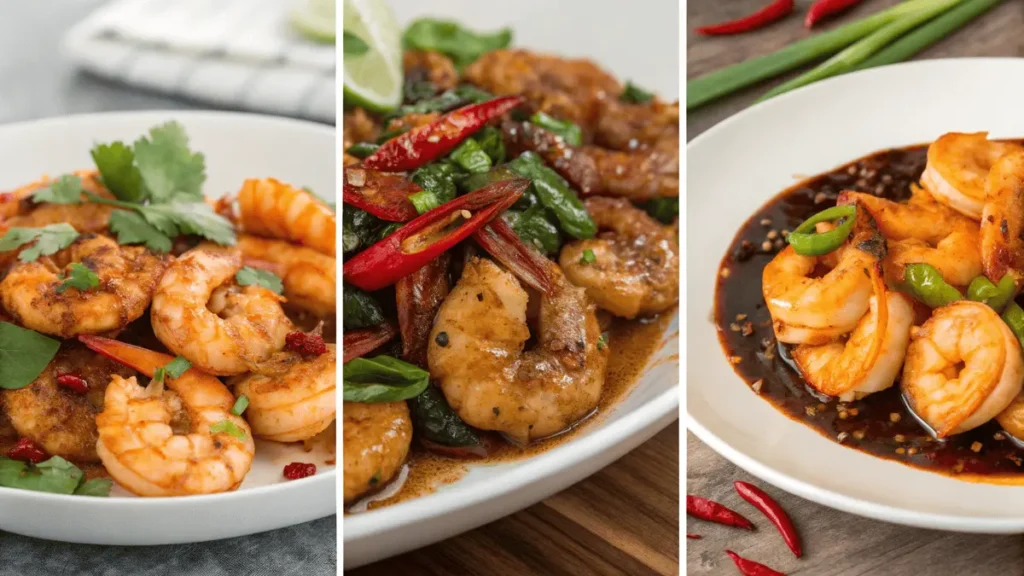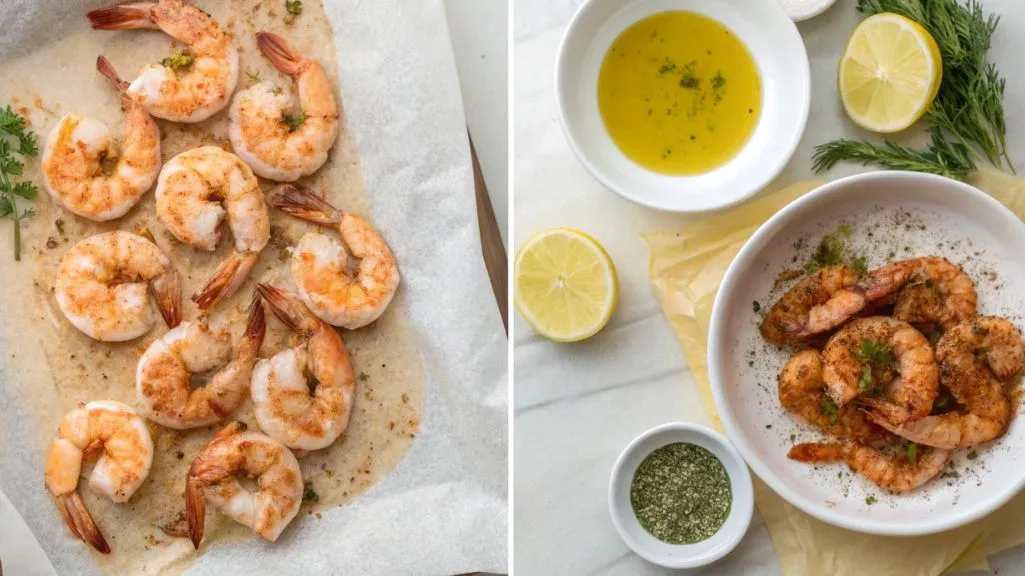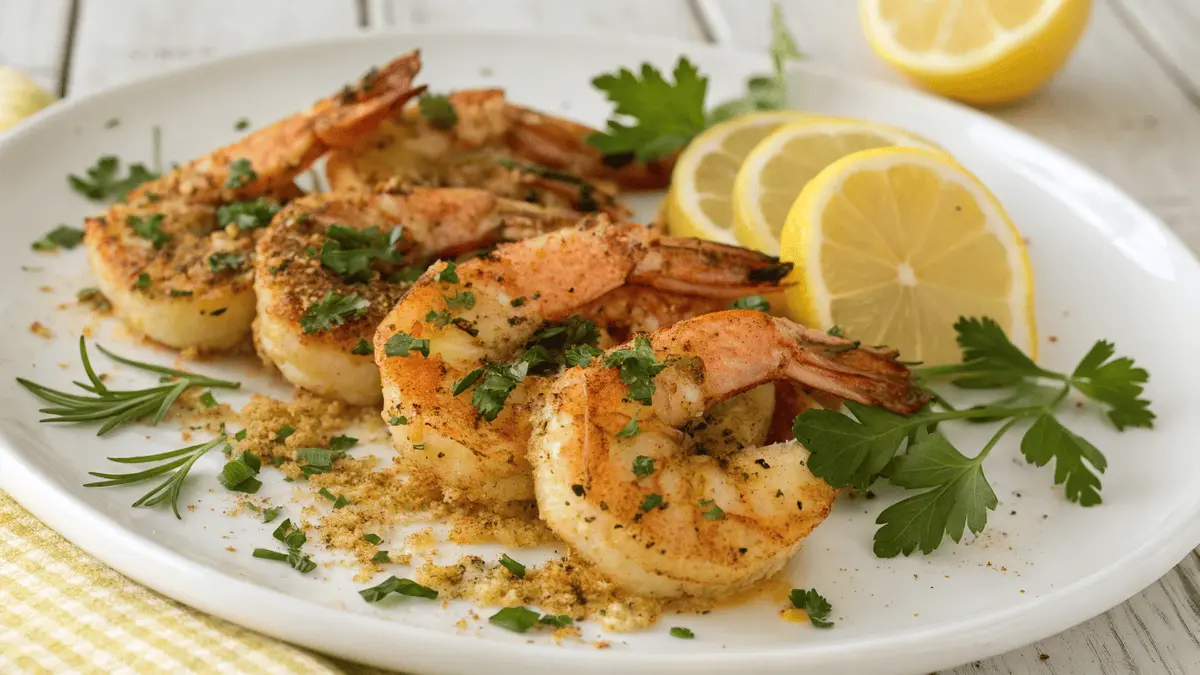Shrimp might be small, but when it comes to flavor, they pack a serious punch, especially when seasoned just right. Whether you’re grilling, sautéing, or baking, the real magic lies in how you flavor them. And that’s where the perfect shrimp seasoning recipe comes in.
In this article, we’ll walk you through everything you need to know about seasoning shrimp—starting from the essential spice blend to different cooking methods, popular seasoning styles around the world, and even pro tips to keep your shrimp juicy and flavorful. You’ll learn how to mix your own dry rub, tweak it to your taste, and pair it with sides and sauces that make the dish pop.
Let’s dive in and uncover what makes a shrimp dish unforgettable—starting with why seasoning matters more than you might think.
Table of Contents
Why the Right Shrimp Seasoning Matters
What Makes Shrimp Unique in Flavor and Texture
Shrimp is unlike any other seafood. It’s tender yet firm, sweet but briny—and quick to soak up flavors. But here’s the catch: it’s also easy to overdo. One wrong move and your shrimp can go from juicy to rubbery in a flash.
That’s where a balanced shrimp seasoning recipe plays its role. Unlike fish or crab, shrimp don’t have much fat. This means they need a little help from the outside—a burst of herbs, spices, and acidity—to truly shine. The seasoning doesn’t just sit on the surface; it seeps in fast, enhancing every bite.
The Role of Seasoning in Enhancing Shrimp Dishes
Let’s face it—plain shrimp is just… meh. But toss it in a blend of paprika, garlic, lemon zest, cumin, and you’ve got yourself a party in your mouth.
Seasoning brings out shrimp’s natural sweetness while adding layers of depth. You can make it spicy and bold like Cajun, zesty like Caribbean rubs, or savory with an Asian-inspired twist. Depending on what you use, the flavor profile can totally change, making shrimp one of the most versatile proteins around.
Simply put, the right shrimp seasoning recipe transforms an ordinary dish into something that makes people go “Wow, what’s in this?!”
Core Components of the Best Shrimp Seasoning Recipe
Essential Herbs and Spices for Shrimp Seasoning
When it comes to building the best shrimp seasoning recipe, starting with the right foundation is everything. So, what’s in that secret blend? A classic combo often includes smoked paprika, garlic powder, onion powder, dried oregano, and black pepper. These create bold, savory notes that complement the shrimp’s natural sweetness.
Add a dash of cayenne or chili flakes for heat, and you’ve got a spicy kick that lingers (in a good way). Don’t forget dried thyme or basil if you want an herby edge. The goal here? Balance. You want the spices to highlight the shrimp—not bury it.
Some folks also toss in a pinch of cumin for a smoky touch or mustard powder to add a mild tang. These little extras make a big difference. And remember, even simple blends can deliver knockout flavor when done right.
Balancing Heat, Sweetness, Acidity, and Umami
Here’s the deal: your seasoning shouldn’t just be hot or salty. You need a bit of everything—sweetness, spice, acid, and a pop of umami. This is how you turn a plain shrimp dish into something crave-worthy.
For sweetness, try a pinch of brown sugar. It’s not just for BBQ—just a little will caramelize beautifully on grilled shrimp. Need acidity? Lemon zest or lime powder can brighten the whole mix. Umami? Add a dash of soy powder, fish sauce (if wet), or even a tiny bit of parmesan dust.
Creating a perfect shrimp seasoning recipe is really about layering flavors. Don’t be afraid to experiment—but keep it balanced. If something’s too salty, sweeten it. If it’s too spicy, mellow it out with herbs.
Using Salt and Citrus to Brighten the Flavor
Finally, let’s talk salt and citrus. Shrimp is already briny, so go easy on the salt—kosher salt works best since it clings to the shrimp without over-salting.
And citrus? Game changer. Add a bit of lemon zest or lime juice just before or after cooking. This not only enhances the spices, but it also keeps the shrimp fresh and vibrant. A squeeze of citrus can pull the whole seasoning together—like the final brushstroke on a painting.
The Best Shrimp Seasoning Recipe (Dry Mix)
Ingredient List with Exact Measurements

Now for the star of the show—the actual shrimp seasoning recipe. This dry mix is versatile, bold, and works for just about every cooking method.
Dry Seasoning Blend:
- 1 tsp smoked paprika
- 1 tsp garlic powder
- ½ tsp onion powder
- ½ tsp cayenne pepper (adjust to taste)
- 1 tsp dried oregano
- ½ tsp ground cumin
- ½ tsp black pepper
- ½ tsp kosher salt
- ½ tsp brown sugar
- Optional: ½ tsp lemon zest powder or dried parsley
This blend brings heat, depth, and a touch of sweetness that plays perfectly with the shrimp’s natural flavor.
Step-by-Step Instructions for Mixing and Storage
To make the seasoning, simply mix all ingredients in a small bowl. Stir well to combine—no fancy tools needed. For best results, store your shrimp seasoning recipe in an airtight spice jar or glass container. Keep it in a cool, dark spot and it’ll stay fresh for up to 6 months.
Before using, pat your shrimp dry, then toss with about 1 tablespoon of seasoning per pound. You can also drizzle a bit of olive oil for even coating.
This dry rub is excellent for grilling, pan-searing, or even air-frying. It sticks to the shrimp, creates a beautiful crust, and guarantees flavor in every bite.
Alternative Shrimp Seasoning Styles You’ll Love

Cajun and Creole Shrimp Seasoning Recipes
If you’re craving bold, fiery flavors, you can’t go wrong with Cajun or Creole. These Southern-style blends are famous for their deep heat, smokiness, and savory kick. While both come from Louisiana, Cajun seasoning tends to be spicier, while Creole brings in more herbs like thyme, oregano, and parsley.
A solid Cajun shrimp seasoning recipe usually includes paprika, cayenne, garlic powder, thyme, and black pepper. Some even throw in a pinch of white pepper for a cleaner heat. It’s perfect for blackened shrimp or shrimp po’boys.
Creole blends, on the other hand, layer in dried basil, celery seed, and often a dash of lemon zest. Great for shrimp stews or gumbos, these mixes let the shrimp shine without overpowering it.
Spicy Asian-Inspired Blends (Thai, Korean, Chinese)
Spice lovers, rejoice—Asian seasoning blends bring a next-level punch. Thai-style shrimp seasoning may include lemongrass powder, galangal, dried chili, and lime peel. Combine with a bit of fish sauce or a squeeze of lime for a tangy, savory bite.
For Korean flair, try adding gochugaru (Korean chili flakes), a hint of ginger powder, and a sprinkle of sesame seeds. This is great for stir-fried or grilled shrimp.
Craving something sweet-spicy? Chinese-inspired blends often include five-spice powder, garlic, brown sugar, and rice vinegar powder. It’s ideal for shrimp tossed in sticky sauces.
These global twists are perfect when you’re tired of the usual. So, go ahead—play with your seasoning. Just keep balance in mind, and don’t forget to taste as you go.
For more seafood flavor inspiration, check out our Sea Scallop Cakes Recipe Guide—a fantastic partner to shrimp on any plate.
Wet Marinades vs. Dry Rubs for Shrimp

Pros and Cons of Each Method
Now that you’ve got your go-to shrimp seasoning recipe, it’s time to talk technique. Should you go dry rub or marinade? Each has its perks.
Dry rubs are quick, easy, and mess-free. They stick right to the shrimp, creating a flavorful crust when cooked. Plus, you don’t need much time—just toss and cook. This method is perfect for grilled, air-fried, or pan-seared shrimp.
Wet marinades, on the other hand, offer deeper flavor. When shrimp sits in oil, citrus, and spices, the flavors soak in fast—sometimes in under 15 minutes. But be careful! Too much acid (like lemon or vinegar) can “cook” the shrimp before it hits the heat, turning it mushy.
When to Use Marinades for Deeper Flavor Penetration
Use a marinade when you’re baking, broiling, or want shrimp with rich, bold undertones. A simple marinade might include olive oil, lemon juice, minced garlic, paprika, and dried herbs. For Asian flair, try soy sauce, sesame oil, and ginger.
Still, don’t let shrimp swim too long—15 to 30 minutes tops. The shrimp are like flavor sponges, so even a short soak does wonders.
Bottom line? Both methods work. Choose based on the time you’ve got and the texture you want. Either way, the right shrimp seasoning recipe ensures flavor in every bite.
Cooking Methods That Complement Great Seasoning
Grilling, Sautéing, and Broiling
Once you’ve nailed the shrimp seasoning recipe, it’s time to cook your shrimp like a pro. The cooking method matters just as much as the spice blend—each technique brings out different textures and flavor notes.
Grilling is perfect for adding a smoky char and bold flavor. Season your shrimp, skewer them, and toss them over medium-high heat for just 2–3 minutes per side. That’s it. Quick and tasty.
Sautéing is your go-to for a juicy, slightly crisp bite. Heat a bit of oil or butter in a pan, toss in your seasoned shrimp, and cook them for 1–2 minutes per side. It’s fast and brings out the garlic, paprika, or herbs in your blend.
Broiling might sound fancy, but it’s super simple. Place seasoned shrimp on a baking tray and broil on high for 2–3 minutes. It adds a caramelized edge, especially if your seasoning has brown sugar or citrus zest.
No matter the method, don’t overcook. Shrimp only need a few minutes—when they curl into a “C” shape and turn pink, they’re done!
Oil, Butter, and Cooking Times for Juicy Results
To keep shrimp juicy, always coat them lightly in oil or butter before cooking. This not only prevents sticking but also helps your shrimp seasoning recipe adhere better.
Shrimp cook fast—really fast. So be ready to flip quickly. Overcooked shrimp turn rubbery and bland, no matter how great your seasoning is.
A hot pan, a slick of oil, and a well-timed flip—that’s your path to shrimp heaven.
Serving Suggestions and Pairings
What to Serve with Seasoned Shrimp (Rice, Salad, Pasta)
You’ve nailed the shrimp seasoning recipe, cooked them to perfection—now what? Let’s talk pairings that make your meal unforgettable.
First up: rice. Whether it’s jasmine, wild, or coconut rice, the neutral flavor lets your seasoned shrimp shine. Want something fancier? Try shrimp over herbed quinoa or couscous for a light, healthy twist.
Salads are a great way to keep things fresh. A tangy mango slaw or a citrusy arugula salad cuts through the spice and adds crunch.
Then there’s pasta. Toss your shrimp with garlic butter noodles, lemon linguine, or even creamy Alfredo. Just make sure the seasoning on your shrimp doesn’t get lost in the sauce—balance is key.
Sauces and Dips That Elevate the Dish (Garlic Butter, Harissa, Cilantro Chutney)
Want to kick things up a notch? A great dip or sauce can take your shrimp from tasty to unforgettable.
Garlic butter is a classic—it complements nearly any shrimp seasoning recipe. For spice lovers, harissa adds bold, smoky heat. And if you want something bright and herbaceous, try a cilantro chutney or lime crema.
Don’t be afraid to experiment here. A drizzle, a dunk, or a spread can turn your shrimp into the star of your next dinner party.
FAQs – Based on ‘People Also Ask’
Q: What spices go well with shrimp?
Shrimp pairs well with a wide range of spices. Popular choices include paprika, garlic powder, cayenne pepper, black pepper, onion powder, cumin, oregano, and thyme. These spices bring out shrimp’s natural sweetness and add depth without overpowering it. For global flair, you can also use ginger, turmeric, coriander, five-spice, or lemongrass powder. The key is balance—use bold spices in moderation to complement the delicate flavor of shrimp.
Q: What is one good way to season or enhance the flavor of shrimp?
One of the best ways to boost shrimp’s flavor is by using a dry rub or quick marinade based on a custom shrimp seasoning recipe. A simple yet powerful mix includes paprika, garlic, cayenne, and a squeeze of lemon juice for brightness. Pat the shrimp dry first so the seasoning sticks, and let it sit for 10–15 minutes before cooking. This method ensures every bite is flavorful, juicy, and seasoned to perfection.
Q: What’s a good seasoning for grilled shrimp?
For grilled shrimp, a bold and slightly smoky dry rub works wonders. Try blending smoked paprika, chili powder, garlic powder, cumin, black pepper, and a pinch of brown sugar for caramelization. This combo creates a flavorful crust and stands up well to the heat of the grill. Adding a little lime zest or lemon juice before serving brightens everything up beautifully.
Q: What is a good seasoning for sautéed shrimp?
Sautéed shrimp shine with a seasoning mix that’s both savory and aromatic. A great go-to includes garlic powder, paprika, black pepper, oregano, and a splash of citrus juice. Cooking in olive oil or butter helps the spices release their flavors and coat the shrimp evenly. Don’t overcook—just 4–5 minutes is enough to get tender, flavor-packed results.
Conclusion – Make Your Shrimp Unforgettable
Shrimp may be simple to cook, but with the right shrimp seasoning recipe, they can taste like you spent hours prepping. Whether you lean toward bold Cajun flavors, zesty citrus blends, or spicy Asian twists, the right mix of herbs and spices can elevate every bite.
From dry rubs to wet marinades, from quick sautés to smoky grills, you now have the tools to season shrimp like a pro. Pair your shrimp with rice, salad, or pasta, and don’t forget those next-level sauces that bring the whole plate together.
So go ahead—mix up that seasoning, taste as you go, and don’t be afraid to tweak it. Cooking shrimp isn’t just fast—it’s fun, flexible, and bursting with flavor when done right.
Now that you’ve mastered your seasoning, it’s time to turn on the stove, fire up the grill, or grab that skillet. Your perfect shrimp dish is just minutes away.
For more details shrimp recipes, check out List of shrimp dishes.

